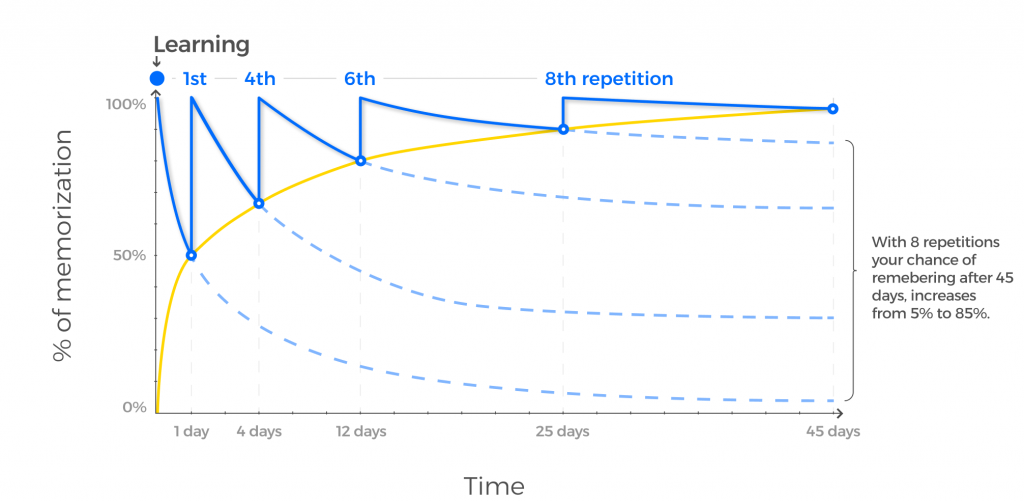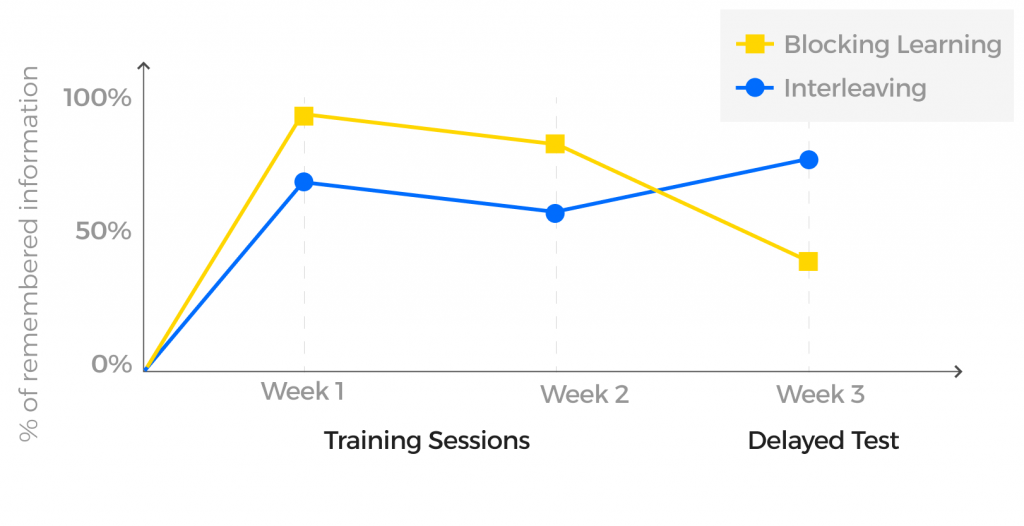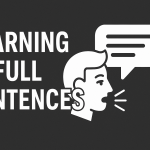When was the last time you felt that something came to you with such great difficulty, you almost had to force yourself to do it? And then, after much struggle, suddenly something “clicked” and you felt that wonderful relief of understanding? Such a moment of enlightenment is proof that learning takes time and effort. And true understanding does not come easily.
For many people, learning a new language is a passion and a way to grow, but at the same time a huge challenge. But overcoming obstacles and achieving goals is what gives us the greatest satisfaction. These are the moments that we remember for a long time!
In this article, we will examine the concept of “desirable difficulties” in language learning and see why a certain type of difficulty encountered in the learning process is beneficial to gaining proficiency. We’ll look at spacing, interleaving and testing strategies – ways to train your language skills to make them stay with you for as long as possible. Get ready for a real mental workout, because, as you’ll soon discover, learning a language is hard!
What are desirable difficulties all about?
The term “desirable difficulties” was introduced in 1994 by Robert and Elizabeth Bjork, American psychologists. They studied the conditions under which learning is most effective. At the time, they noted that certain difficulties in the process of learning a language, although they may initially slow down the progress, in the long run increase the ability to use the knowledge and skills previously acquired.
This is how the theory of “desirable difficulties” was developed. The Bjorks defined them as challenges that we create intentionally during learning to induce better memorization and knowledge transfer, i.e. the ability to use the acquired knowledge in another situation. They are “desirable” because, while they hinder immediate performance, they optimize it in the long run – when it really matters. Examples of such difficulties include leaving intervals between repetitions, interleaving different topics while learning, or using tests instead of simple presentations of material.
Contrary to intuition, the best results in the long run come not from easy and pleasant learning methods, but precisely from those that cause some difficulty. Why? When we have to exert more effort, we engage the parts of the brain responsible for the memorization process. The introduction of desirable difficulties activates cognitive mechanisms that consolidate knowledge for much longer. And only with consolidated knowledge will you start speaking like a native speaker.
When is it too easy?
But how do you know whether the level of difficulty is appropriate for building English or Dutch language skills? The easiest way to understand this is through an analogy. Imagine that you go to the gym with the intention of building muscle mass. You exercise regularly, but you use the same light weights each time. Your performance increases week by week, but after a while you start to get frustrated with the lack of visible progress. This happens because exercises that are too easy don’t create enough stress for your muscles to grow.
The exact same thing happens when learning a foreign language. If the exercises are too easy and devoid of challenge, it may seem that we are making progress. In reality, however, such “effortless” learning does not take deep root in our memory and quickly leaves it. That’s why it’s important to intentionally introduce some difficulties that may slow down learning at first glance, but yield better results in the long run. Think of it as adding load – maybe add another verb, more persons and numbers, or a few words relating to the context?
Many popular language learning apps offer exercises that are simply too simple. Matching pictures to words, putting together sentences from given words or simply repeating heard phrases? Solving them is fun like playing a game and good for building motivation to learn, but these are tasks that present you with an almost completely solved puzzle. Yes, such learning can create an illusion of progress, especially when combined with a points and rewards system. But think about it, what happens when you have to put together a sentence on your own, in a real-life situation? And on top of that, to use it proficiently? Not so easy, is it?
These applications often motivate us to repeat the same elements too often, sometimes even several times a day. Therefore, they do not provide the opportunity to forget the material and, consequently, the opportunity to recall it later – and this is a key element of permanent memorization. The algorithms used in these programs are optimized for user engagement, not long-term memorization. Like strength training, mastering a language requires a thoughtful plan and the introduction of gradually increasing challenges. Otherwise, it may appear that we are making progress, but in reality we are only deceived by a short-term boost in performance that quickly evaporates.
How to use desirable difficulties in language learning
Instead of a game that creates the illusion of progress, try treating language learning like a real workout: exhausting, but bringing a sense of achievement of an important goal, and above all, results. You will benefit from them exactly when you really need them! Here are three key “desirable difficulty” strategies for language learners that you can use.
Spacing and forgetting
The spaced learning effect is one of the most fascinating effects in the entire history of experimental research on learning and memory. If carried out correctly, the effect is so strong that you can remember what you’ve learned for 10 or 15 years – or even forever.
Spacingis one of the most effective “difficulties” we can add to learning Italian, German, Dutch, or any other language. The idea here is to spread out sessions of repeating material over time, instead of “cramming” everything into one session. Start learning with a small batch of material, and then return to it at regular intervals, each time extending the time between repetitions. This method requires more work, but paradoxically it leads to better results in the long run.
Why? Because the natural consequence of this method is forgetting. This may seem undesirable, but in fact, each recall and re-“extraction” of information from memory creates new associations and modifies our knowledge. The more effort we have to make to repeat the material, the more the forgetting curve flattens, which means that we will forget more slowly and soon raise our level of language proficiency!
However, how much time does it take to forget properly? Here the Spaced Repetition algorithm, which we use in Taalhammer, comes to the rescue. It precisely calculates when you should recall an item in order to remember it for a long time. Each recollection of forgotten content modifies our memory, and the goal of the algorithm is to balance on the edge of forgetting – to repeat the material right after we forget it.

Learning by interleaving
Interleaving is the most counterintuitive and surprising “desired difficulty.” Interleaving means mixing different categories while learning, for example:
- vocabulary along with pronunciation
- grammar of a foreign language
- phrases
- topics
- structures.
For example, instead of learning one grammatical tense and then moving on to shopping vocabulary, it is better to interleave these elements.
Such a method requires more effort during learning, but it leads to better results in the long run. Forcing the mind to constantly “reload” patterns and strategies reinforces learning. As a result, you will be able to react naturally to a new situation involving a foreign language and use the right expressions without problems.
Interestingly, many learners are convinced that blocked learning is more effective. Meanwhile, research shows that even after seeing worse results in a test, participants still believed that learning “in blocks” was better! This shows how attached we are to our habits and intuitions, even when the evidence contradicts their effectiveness.

Testing, choosing, and answering
Forgetting and interleaving, however, are not all the difficulties to use in learning a language. There is also a third element: testing. This is probably the most misunderstood tool in education. We tend to think of it as a way to assess progress, rather than as part of the learning itself. However, taking tests – that is, pulling information from our memory – is much better for long-term memorization than repeating material over and over again.
Recalling refreshes memory and makes the recalled information more accessible in various life situations. The more often we review knowledge, the more we reduce our anxiety about using a skill. This is incredibly important for learning a foreign language effectively.
In addition to tests, a great exercise is to create answers yourself instead of choosing them from a ready-made list. Any situation in which you have to say a word, put together a sentence, or write down an explanation yourself, instead of simply reading it or choosing it from a list, is a valuable learning opportunity. This difficulty, called the “generating principle,” forces you to process information more deeply and creates more permanent connections in memory.
Take up the challenge with Taalhammer: learn a language!
Learning a language has to be difficult. It’s the key to lasting knowledge. Therefore, sit back and concentrate. This is your warm-up for the real training of overcoming “desirable difficulties”! A slalom of spacing, interleaving and testing awaits you – because these are the keys to successful knowledge acquisition. More in our article about effective principles in language learning.
If you want to experience these strategies in practice and start speaking like a native speaker, we strongly encourage you to take up the challenge with the Taalhammer app. It is designed to introduce “desirable difficulties” in a natural and effective way. After an hour-long session, you’ll be mentally exhausted – exactly like after a solid workout. But this well-designed “squeeze” will bring results where they count most – in real communication.
Don’t procrastinate – see how much you can achieve when you discard old habits and take on the challenge of learning with “desirable difficulties.” Success in learning a language never comes easy, but with the right approach it is within reach. Get to work!







